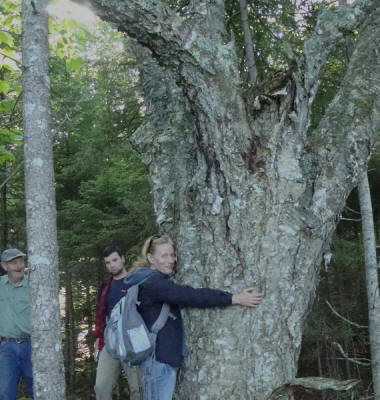
Yellow Birch - photo by Jennifer Dudley
 Maine
Maine
| On March 14, 2010 the Eastern Native Tree
Society and Western Native Tree Society switched from
discussion lists on Google Groups to a new discussion
list in a Bulletin Board format at:
http://www.ents-bbs.org/index.php
Posts made since the inception of the BBS on March 14,
2010 will be sorted and archived on the BBS. Click on
the link to go to the equivalent section on the new BBS.
This website will continue to serve as a front end for
the ENTS and WNTS groups. It will continue to serve as a
repository of older posts, and will serve as the host
site for special projects and features that are not well
suited for a BBS format. Please visit the BBS for the
latest information and trip reports. |
Field Trips
-
herbie the elm tree in Maine
The largest elm tree in New England recently died and had to be
cut down. This is a link to an article on the tree that just
came out. Sincerely, Russ Richardson _[link]
([link])
-
Globe article on Herbie the Elm coming down Here's another article with an
impressive photo of the demise of the old Maine elm:
[link] - Laura Garcia
Jan 19, 2010.
-
Maine's 240-year-old elm tree, Herbie, comes
down Forward from former member
Randy Cyr Maine's 240-year-old elm tree, Herbie, comes down
Published: 1/19/10, 12:05 PM EDT By DAVID SHARP YARMOUTH, Maine
(AP) - New England's largest and oldest elm tree has been cut
down. Workers using a bucket truck and crane cut down the tree,
known as Herbie, on Tuesday. It had stood in Yarmouth since
before the American Revolution....
more » Jan 19, 2010.
-
new book on Trees in Maine
a new book on the trees of Maine came out recently.
Apparently, it is a smash hit, and we are not talking a blowdown:
http://www.necn.com/Boston/Arts-Entertainment/2010/01/11/Forest-Trees-of-Maine-is/1263246489.html
By neil - Jan 13,
2010
-
When This Tree Falls - Globe article
January 3, 2010
- When This Tree Falls - American Elm
http://www.boston.com/news/local/maine/articles/2009/12/27/when_this_tree_falls_he_will_feel_it/
- Acadia Maine August 1, 2009

- New England Hikes
July 30, 2009
-
Mount Katahdin Maine July 28, 2009

- Maine Coast
July 26, 2009

-
Maine
Forest Ecosystem Workshop July 21, 2009

- Maine
Beeches and Hemlocks July 15, 2009

- Eagle Hill, Steuben Maine Forest Seminar
http://groups.google.com/group/entstrees/browse_thread/thread/3045870ac2a55f2f?hl=en
- Question about Baxter State Park
http://groups.google.com/group/entstrees/browse_thread/thread/563cf475ab882412?hl=en
June 25, 2009
- Acadia National Park ME
May 2008
- Bowdoin College
Pines Dec 2006
- Ordway Pines Nov
2006
- Sunkhaze meadows
NWR Oct 2006
- Herbie - Big Elm in Maine
Jan 2008
Country of the Pointed Firs, Sarah Orne Jewett, written
in 1896:
--Mrs. Todd speaking to her companions as they travel up-country
Maine on
the way to a family reunion.--
'"There's sometimes a good hearty tree growin' right out of
the bare rock,
out o' some crack that just holds the roots;" she went on
to say, " right
on the pitch o' one 'o them bare stony hills wehre you can't
seem to see a
wheel-barrowful o' good earth in a place, but that tree'll keep
a green top
in the driest summer. You lay your ear down to the growth an'
you'll hear
a little stream runnin'. Every such tree has got it own livin'
spring;
there's folks made to match 'em."'--
- Acadia National Park http://www.nps.gov/acad/index.htm
Located on the rugged coast of Maine, Acadia
National Park encompasses over 47,000 acres of granite-domed
mountains, woodlands, lakes and ponds, and ocean shoreline.
Comprised of a cluster of islands on the Maine coast, Acadia is
positioned within the broad transition zone between eastern
deciduous and northern coniferous forests, and hosts several species
and plant communities at the edge of their geographic range. Steep
slopes rise above the rocky shore, including Cadillac Mountain,
which at 1,530 feet is the highest point on the U.S. Atlantic
coast. Much of the park is covered by spruce-fir
forests, which is representative of the boreal influence, however,
Acadia also contains stands of oak, maple, beech, and other
hardwoods more typical of most of New England. There are also
several unique, isolated forest communities, such as pitch pine and
scrub oak woodlands, that are found in the park at their
northeastern range limit. Similarly, jack pine reaches the southern
limit of its range in Acadia.
-
Live view Acadia National Park (webcam) http://www.hazecam.net/acadia.html
- Notes from the Field Blog: North Woods, Maine 2009
http://earthobservatory.nasa.gov/blogs/fromthefield/category/north-woods-maine-2009/?src=eoa-features
NASA's Dr. Jon Ranson is on an expedition in the forests of
central Maine to validate recent radar and lidar measurements which
will help create more accurate and sensitive sensors to better
understand the vegetation of the Earth and to balance the carbon
budget.
- Forest Ecology Network http://www.powerlink.net/fen/ The purpose of the Forest Ecology Network is to protect, preserve, and defend the native forest environment of Maine through public awareness, grassroots citizen activism, and education
- Mount Katahdin, in Baxter State Park, Maine (Piscataquis
County): approximately 5,000 acres of uncut subalpine forest divided
among several locations including North Peaks and Northwest Basin.
The forest is almost entirely balsam fir. http://www.baxterstateparkauthority.com/
- Maine's Changing Forests http://www.maine.gov/doc/mfs/woodswise/timeline.html
- Maine Woods National Park (proposal) http://www.restore.org/
- Maine Forest Facts http://www.state.me.us/doc/foliage/kids/meforestfacts.html
- "Established in 1894, the W.S. Wells & Sons cannery in
Wilton (Maine), (pop.4,123) is the only fiddlehead fern cannery in
the nation. The company sells nearly 50,000 pounds of the seasonal
delicacy each year." source: Greenfield (MA) Recorder,
01/08
|